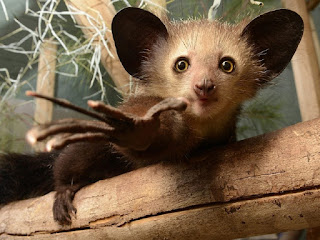
The Ayeaye is a long-toed lemur, a strepsirrhin primate native to Madagascar with constantly growing rodent teeth and a special thin middle finger. It is the largest nocturnal primate in the world. This animal can only be found in the northeastern parts of Madagascar. Aye-aye is listed as nearly threatened species and it is currently under protection.
The aye-aye’s tail has the longest hairs of any prosimian (a group including lemurs and tarsiers) at over 9 inches long.
Aye-aye is a small animal that can reach 14 to 17 inches in length and weight of up to 4 pounds. Its tail is longer than its body, reaching up to 24 inches in length.
Aye-ayes sleep in treetop nests they construct.
Aye-aye is a type of lemur, although it looks like a mixture of several different animals. It has incisors like rodent, claws like sloth, face like weasel and body like monkey.
Adult aye-ayes spend most of their lives alone, only hanging with other aye-ayes during courtship and when the young are dependent on their mother.
Body of aye-aye is covered with brown coat with few white hairs. It has large eyes and large, sensitive ears.
Aye-ayes mark their territories with urine and scent glands on their cheeks, necks, and rumps.
Aye-aye is nocturnal (active at night) animal, that spends most of its life high in the treetops.
Females have smaller territories that often overlap those of at least a few males.
Aye-aye eats insect larva, nectar, seed, fruit and fungi.
Male aye-ayes tend to tolerate sharing territory with other males, and will even sleep in the same nests but not at the same time.
It has specifically designed middle finger which is used for extraction of food from trunks, braches and hard shells. This finger is very thin (looks like it is made of skin and bones) and it can be three times longer than other fingers.
Their hands are large for their bodies, and their fingers are long and narrow.
Aye-aye taps a branch with its finger and listens is there is any sound of moving insects or larvae inside. If the movement is detected, aye-aye will make a hole with sharp teeth and use its middle digit to scoop the prey.
They can tap at a rate of up to eight times per second.
Aye-aye spends a day in nests in the trees. It builds several nests of twigs and leaves on its territory and it often changes its location to escape from the predators.
The huge, bat-like ears of the aye-aye are lined with a complex series of ridges, which help to focus sounds during percussive foraging.
Besides humans, main predators of aye-aye are fossa and birds of prey.
Aye-ayes scream to indicate aggression, and a closed-mouth variation of this scream can indicate protest.
Aye-aye is a solitary creature that gathers with other aye-ayes only for mating.
When competing over food aye-ayes emit a brief descending whimper.
Aye-aye does not have specific time of the year when it mates. It can reproduce throughout the whole year.
An extinct form of the aye-aye (Daubentonia robusta) once lived in southwest Madagascar.
When the female is ready for reproduction, she will vocalize to inform the males.
The Red List of Threatened Species published by the International Union for Conservation of Nature and Natural Resources lists the aye-aye as an endangered species.
Pregnancy in females lasts 160 days and ends with one baby that spends first two months of its life in the nest. Aye-aye depends on mother’s milk during the first seven months, but it will stays with its mother until the age of two years.
Successful breeding colonies have been established on a few small islands near Madagascar, and some aye-ayes are kept in captivity in a few zoos outside the country.
Aye-aye reproduces every 2-3 years and it becomes sexually mature at age of 3 – 3.5 years.
The female aye-aye bears a single young.
Average lifespan in captivity is 20 to 23 years. Lifespan in the wild is unknown.










This was really interesting to read! I learned a lot from this post and it has given me a new perspective on the topic. The author did a great job of presenting the information in a way that was easy to understand and engaging. The post was well-researched and provided a lot of valuable insights that I hadn’t considered before. It’s always great to learn something new, and this post definitely delivered on that front. I feel like I have a better understanding of the topic now, and I’m grateful for that.